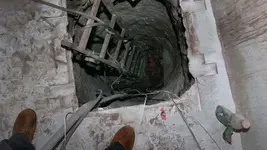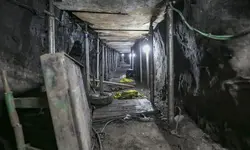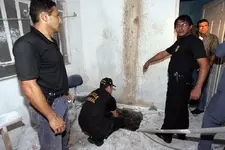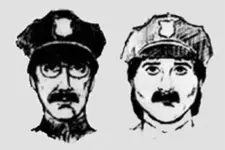KANACKI
Bronze Member
- Joined
- Mar 1, 2015
- Messages
- 1,445
- Reaction score
- 5,940
- Golden Thread
- 0
- Primary Interest:
- All Treasure Hunting
Hello All
Grab a some of Don Jose famous sock coffee and pull up seat I have an interesting yarn for you. In regards to proceeds of crime becoming modern buried loot. The following story is from recently as 2005.
Although a crime is crime you some times have to admire audacity of some criminals. Have any of you heard about the Banco Central robbery in Fortaleza, Brazil?
Banco Central robbery in Fortaleza, Brazil.

The Guinness Book of World Records awarded this heist the title of "greatest robbery of a bank," and the plot sounds like something straight out of a movie.
At 6 p.m. on Friday, August 6, 2005, in downtown Fortaleza, Avenida Dom Manuel was packed with Brazilians racing home to shower and eat before crowding into the beach huts lining the boardwalk of this coastal city. Little did they know, 13 feet beneath the asphalt, honking and clatter, one of the greatest heists in history was already underway.

The haul from the Banco Central was 165 million reais — roughly $70 million USD all in 50 real bills that had been set aside for sorting to determine which notes were damaged and needed to be destroyed. Stacked up, they would have reached 108 feet and weighed a ton. So it would’ve been a massive task to get them through the 260-foot-long tunnel that led from the serrated hole in the ceramic floor of the bank, under the avenue and into the back of a store a block away.

Three months earlier, the robbers rented their cover, a store they fronted with a farcically parochial sign: “Synthetic Grass.” When questioned later, neighbors recalled not thinking much of the new business, or the trucks filled with 30 tons of dirt that drove in and out for weeks. When bank employees discovered what had happened on Monday, the criminals (police say 25 were involved) were already divided into 11 cars headed in different directions throughout Brazil, and the details that emerged shocked the nation.

The tunnel they had dug, filling all those truckloads, was a masterful engineering project: 28 inches in diameter, complete with wooden beams, ladders, plastic lining, wiring and even an air-conditioning and ventilation system. The cash had been pulled manually through the tunnel — which police estimated had cost nearly $200,000 to construct — via basins secured to ropes squeaking through a pulley system.
It would appear they’d thought of everything: Outside, police would later find a large amount of white powder — chalk the robbers had used to cover their fingerprints. And they nearly succeeded, except for one print, their first slip.
The second mistake? A member of the gang bought 10 cars at once the next day, paying cash and raising red flags in this poor region of Brazil. Improbably, the police managed to catch up with the trailer carrying those cars in another state, and inside three of the vehicles were bundles of 50 real bills.
The nabbed man squealed, taking down the group. As with most heists, they’d had an inside man — a bank employee who’d tipped them off to the location of motion sensors, alarms and the fact that the cameras filmed but did not record. The biggest shock? The mayor of Boa Viagem, a podunk town south of Fortaleza, was also in on it, and had fronted some of the money to build the tunnel, which made the town an attractive hideout for many of the suspects.
Three dozen of them were accused, and 26 ended up in jail — for 133 crimes. “Armadillo,” nicknamed for his digging skills, was nabbed at his favorite bakery in São Paulo and sentenced to 17 years, later reduced to two. “Big Boss,” the tunnel’s engineer, escaped prison in 2011 and is still on the run. But things may have turned out best for those stuck in prison. While on the lam, “Little Fernando” was kidnapped, held for ransom and killed, his bullet-riddled body found on a rural roadside.
The fallout of the decade-old crime, in fact, is still playing out. The ringleader, aka “The German,” was arrested in Brasília three years later and slapped with a lengthy sentence; more recently, a judge found him guilty of money laundering and tacked on another 80 years. Antônio Reginaldo de Araujo, who police believe had become a narcotrafficking kingpin of a São Paulo neighborhood, escaped jail on Father’s Day last year, but was recaptured this summer driving a car stocked with cocaine and cell phones.
In the end, 20 million of the 165 million reais — about $8 million of the $70 million — were recouped, leaving little hope any more will be found. According to the police chief in charge of the investigation, Antônio Celso dos Santos, “there’s no way to recover more of the money” now that so much time has passed. Some say the bills are buried in the desert?
Clearly amigos much of money has been disbursed. But I have no doubt for the ones still in prison or have already been murdered that there is still caches hidden all over Brazil perhaps over 50 million.
No doubt in years to come there will be a whole host of treasure hunters in the future looking for some of the proceeds of that crime?
Coffee anyone?
Kanacki
Grab a some of Don Jose famous sock coffee and pull up seat I have an interesting yarn for you. In regards to proceeds of crime becoming modern buried loot. The following story is from recently as 2005.
Although a crime is crime you some times have to admire audacity of some criminals. Have any of you heard about the Banco Central robbery in Fortaleza, Brazil?
Banco Central robbery in Fortaleza, Brazil.

The Guinness Book of World Records awarded this heist the title of "greatest robbery of a bank," and the plot sounds like something straight out of a movie.
At 6 p.m. on Friday, August 6, 2005, in downtown Fortaleza, Avenida Dom Manuel was packed with Brazilians racing home to shower and eat before crowding into the beach huts lining the boardwalk of this coastal city. Little did they know, 13 feet beneath the asphalt, honking and clatter, one of the greatest heists in history was already underway.

The haul from the Banco Central was 165 million reais — roughly $70 million USD all in 50 real bills that had been set aside for sorting to determine which notes were damaged and needed to be destroyed. Stacked up, they would have reached 108 feet and weighed a ton. So it would’ve been a massive task to get them through the 260-foot-long tunnel that led from the serrated hole in the ceramic floor of the bank, under the avenue and into the back of a store a block away.

Three months earlier, the robbers rented their cover, a store they fronted with a farcically parochial sign: “Synthetic Grass.” When questioned later, neighbors recalled not thinking much of the new business, or the trucks filled with 30 tons of dirt that drove in and out for weeks. When bank employees discovered what had happened on Monday, the criminals (police say 25 were involved) were already divided into 11 cars headed in different directions throughout Brazil, and the details that emerged shocked the nation.

The tunnel they had dug, filling all those truckloads, was a masterful engineering project: 28 inches in diameter, complete with wooden beams, ladders, plastic lining, wiring and even an air-conditioning and ventilation system. The cash had been pulled manually through the tunnel — which police estimated had cost nearly $200,000 to construct — via basins secured to ropes squeaking through a pulley system.
It would appear they’d thought of everything: Outside, police would later find a large amount of white powder — chalk the robbers had used to cover their fingerprints. And they nearly succeeded, except for one print, their first slip.
The second mistake? A member of the gang bought 10 cars at once the next day, paying cash and raising red flags in this poor region of Brazil. Improbably, the police managed to catch up with the trailer carrying those cars in another state, and inside three of the vehicles were bundles of 50 real bills.
The nabbed man squealed, taking down the group. As with most heists, they’d had an inside man — a bank employee who’d tipped them off to the location of motion sensors, alarms and the fact that the cameras filmed but did not record. The biggest shock? The mayor of Boa Viagem, a podunk town south of Fortaleza, was also in on it, and had fronted some of the money to build the tunnel, which made the town an attractive hideout for many of the suspects.
Three dozen of them were accused, and 26 ended up in jail — for 133 crimes. “Armadillo,” nicknamed for his digging skills, was nabbed at his favorite bakery in São Paulo and sentenced to 17 years, later reduced to two. “Big Boss,” the tunnel’s engineer, escaped prison in 2011 and is still on the run. But things may have turned out best for those stuck in prison. While on the lam, “Little Fernando” was kidnapped, held for ransom and killed, his bullet-riddled body found on a rural roadside.
The fallout of the decade-old crime, in fact, is still playing out. The ringleader, aka “The German,” was arrested in Brasília three years later and slapped with a lengthy sentence; more recently, a judge found him guilty of money laundering and tacked on another 80 years. Antônio Reginaldo de Araujo, who police believe had become a narcotrafficking kingpin of a São Paulo neighborhood, escaped jail on Father’s Day last year, but was recaptured this summer driving a car stocked with cocaine and cell phones.
In the end, 20 million of the 165 million reais — about $8 million of the $70 million — were recouped, leaving little hope any more will be found. According to the police chief in charge of the investigation, Antônio Celso dos Santos, “there’s no way to recover more of the money” now that so much time has passed. Some say the bills are buried in the desert?
Clearly amigos much of money has been disbursed. But I have no doubt for the ones still in prison or have already been murdered that there is still caches hidden all over Brazil perhaps over 50 million.
No doubt in years to come there will be a whole host of treasure hunters in the future looking for some of the proceeds of that crime?
Coffee anyone?
Kanacki
Last edited:










